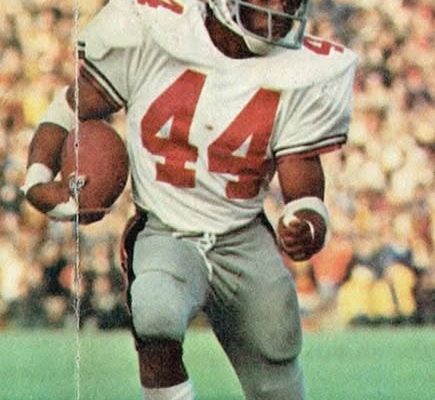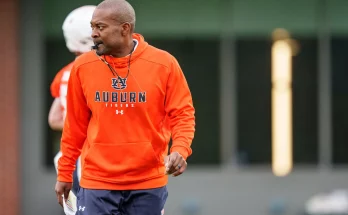Ohio Legend Forever: Ray Griffin’s Iconic Interception That Defined a Rivalry and Cemented a Legacy
Raymond Griffin’s name is etched in Ohio State football lore not only for his talent and accomplishments on the field but also for a single, electrifying moment that captured the heart of a rivalry and turned the tide of a season. Born on June 26, 1956, in Columbus, Ohio, Griffin’s story begins in the heart of Buckeye country and unfolds into a legacy defined by poise, grit, and an unforgettable play that changed the trajectory of one of college football’s greatest rivalries. A proud alumnus of Eastmoor High School, Griffin’s football journey kept him close to home, continuing at The Ohio State University where he played under legendary head coach Woody Hayes. As a cornerback for the Buckeyes, Griffin developed a reputation for being a tough, cerebral defender with a knack for making big plays when it mattered most. But it was one game, one interception, and one drive in 1975 that forever carved his name into the memories of Buckeye fans and into the annals of college football history.
The setting was The Game—Ohio State vs. Michigan—the most storied rivalry in college football. On that fateful day in 1975, with the teams locked in a fierce 14-14 battle late in the fourth quarter, the tension inside the stadium was palpable. Fans knew that more than pride was at stake. The winner of the game would go on to the Rose Bowl, and the loser would be left with only bitter memories. In a moment that defined not only the game but Griffin’s entire college career, Michigan quarterback Rick Leach dropped back to pass, looking to lead his team to victory. But Ray Griffin had other plans. Reading the play with pinpoint precision, he broke on the throw and intercepted the pass, immediately igniting the stadium. It wasn’t just the pick—it was what he did next. Returning the ball deep into Michigan territory, Griffin set up the Buckeyes inside the 10-yard line. What followed was a thunderous surge by fullback Pete Johnson, who barreled into the end zone for the go-ahead touchdown. With that score, Ohio State punched their ticket to the 1976 Rose Bowl and cemented Griffin’s place in Buckeye immortality.
The interception wasn’t just a highlight—it was a turning point. It symbolized the grit and resilience of an Ohio State team that refused to lose, and it perfectly encapsulated Griffin’s role as a playmaker on the defensive side of the ball. The fact that it came in such a high-stakes moment, against a hated rival, made it all the more iconic. It was a play born of preparation, instinct, and a relentless will to win—qualities that Griffin displayed throughout his career in scarlet and gray.
Griffin’s Ohio State tenure was defined by consistent excellence. While often remembered for that defining interception, he was much more than a one-play wonder. As a defensive back, he brought intelligence and leadership to the secondary, helping to anchor a unit that was among the nation’s best during the mid-1970s. His ability to read offenses, anticipate routes, and make game-changing plays earned him respect not only from teammates and coaches but from opponents across the country. He played with the type of toughness that epitomized Woody Hayes’ philosophy, and his impact stretched beyond the stat sheet. Griffin was a leader, a competitor, and a true Buckeye through and through.
After his collegiate career concluded, Ray Griffin took the next step and entered the 1978 NFL Draft. His collegiate success did not go unnoticed, as the Cincinnati Bengals selected him in the second round. Griffin would go on to play seven seasons in the NFL, all with the Bengals, bringing his trademark competitiveness and football IQ to the professional level. While his pro career was steady and productive, it was his time at Ohio State—and particularly that 1975 interception—that defined his legacy.
Griffin’s contributions were formally recognized in 2012 when he was inducted into the Ohio State Football Hall of Fame. The honor was a long-overdue celebration of a player whose name still sparks cheers among Buckeye fans decades later. It was not only a recognition of statistical achievements but a tribute to a moment that continues to live on in the hearts of those who witnessed it. That induction ceremony served as a reminder of just how deeply Griffin’s presence is felt in Columbus and beyond, a testament to the kind of impact that can only come from moments forged in rivalry and remembered in victory.
To understand Griffin’s legacy, one must also understand the cultural and emotional weight of the Ohio State–Michigan rivalry. In Columbus, that game is more than a football contest—it’s an annual battle for bragging rights, pride, and, more often than not, championship aspirations. For a player to rise above the noise and pressure of that game and make the play that decides it is to achieve football immortality. Ray Griffin did exactly that. His interception of Rick Leach didn’t just win a game. It preserved a season. It propelled the Buckeyes to Pasadena. And it gave Ohio State fans a moment they would never forget.
Griffin also carried the legacy of his family. He is the younger brother of two-time Heisman Trophy winner Archie Griffin, the only player in college football history to win the prestigious award twice. While Archie’s accomplishments are legendary, Ray never played in his brother’s shadow. Instead, he carved his own path, becoming a Buckeye legend in his own right. Together, the Griffin brothers helped shape an era of Ohio State football that remains among the most celebrated in program history. Ray’s contributions on defense were just as vital as Archie’s on offense, and the bond they shared as teammates made their story even more compelling.
Ray Griffin’s life and career reflect the best of what Ohio State football represents—excellence, resilience, leadership, and the ability to rise to the moment when everything is on the line. His story continues to be shared among generations of fans, and his name remains synonymous with greatness in the city of Columbus. He didn’t just play the game—he changed the game, and for that, he will forever be remembered.
Whether in highlight reels, Hall of Fame plaques, or the stories told by parents to their children about that unforgettable game in 1975, Ray Griffin’s legacy is secure. He was more than a great cornerback. He was a hero on one of college football’s biggest stages. He was the man who read a play, made a pick, and helped send the Buckeyes to the Rose Bowl. And for that, Ray Griffin will forever be known as one of Columbus’ all-time greats.



